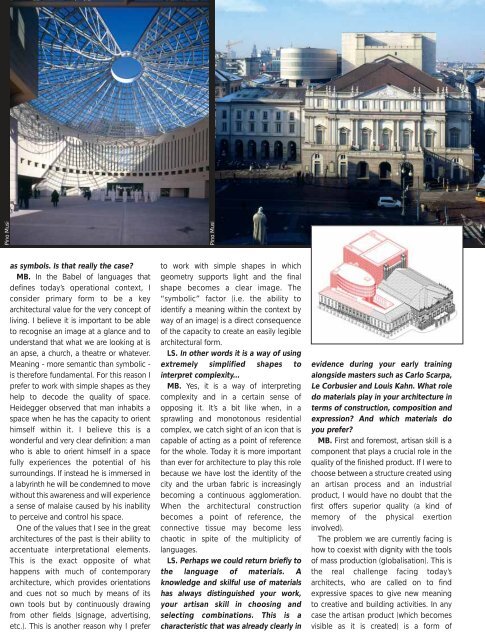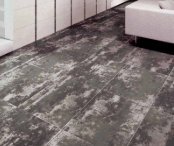Cer Magazine International n.20 - Tilmar Ceramics
Cer Magazine International n.20 - Tilmar Ceramics
Cer Magazine International n.20 - Tilmar Ceramics
You also want an ePaper? Increase the reach of your titles
YUMPU automatically turns print PDFs into web optimized ePapers that Google loves.
Pino Musi<br />
as symbols. Is that really the case?<br />
MB. In the Babel of languages that<br />
defines today’s operational context, I<br />
consider primary form to be a key<br />
architectural value for the very concept of<br />
living. I believe it is important to be able<br />
to recognise an image at a glance and to<br />
understand that what we are looking at is<br />
an apse, a church, a theatre or whatever.<br />
Meaning - more semantic than symbolic -<br />
is therefore fundamental. For this reason I<br />
prefer to work with simple shapes as they<br />
help to decode the quality of space.<br />
Heidegger observed that man inhabits a<br />
space when he has the capacity to orient<br />
himself within it. I believe this is a<br />
wonderful and very clear definition: a man<br />
who is able to orient himself in a space<br />
fully experiences the potential of his<br />
surroundings. If instead he is immersed in<br />
a labyrinth he will be condemned to move<br />
without this awareness and will experience<br />
a sense of malaise caused by his inability<br />
to perceive and control his space.<br />
One of the values that I see in the great<br />
architectures of the past is their ability to<br />
accentuate interpretational elements.<br />
This is the exact opposite of what<br />
happens with much of contemporary<br />
architecture, which provides orientations<br />
and cues not so much by means of its<br />
own tools but by continuously drawing<br />
from other fields (signage, advertising,<br />
etc.). This is another reason why I prefer<br />
Pino Musi<br />
to work with simple shapes in which<br />
geometry supports light and the final<br />
shape becomes a clear image. The<br />
“symbolic” factor (i.e. the ability to<br />
identify a meaning within the context by<br />
way of an image) is a direct consequence<br />
of the capacity to create an easily legible<br />
architectural form.<br />
LS. In other words it is a way of using<br />
extremely simplified shapes to<br />
interpret complexity...<br />
MB. Yes, it is a way of interpreting<br />
complexity and in a certain sense of<br />
opposing it. It’s a bit like when, in a<br />
sprawling and monotonous residential<br />
complex, we catch sight of an icon that is<br />
capable of acting as a point of reference<br />
for the whole. Today it is more important<br />
than ever for architecture to play this role<br />
because we have lost the identity of the<br />
city and the urban fabric is increasingly<br />
becoming a continuous agglomeration.<br />
When the architectural construction<br />
becomes a point of reference, the<br />
connective tissue may become less<br />
chaotic in spite of the multiplicity of<br />
languages.<br />
LS. Perhaps we could return briefly to<br />
the language of materials. A<br />
knowledge and skilful use of materials<br />
has always distinguished your work,<br />
your artisan skill in choosing and<br />
selecting combinations. This is a<br />
characteristic that was already clearly in<br />
evidence during your early training<br />
alongside masters such as Carlo Scarpa,<br />
Le Corbusier and Louis Kahn. What role<br />
do materials play in your architecture in<br />
terms of construction, composition and<br />
expression? And which materials do<br />
you prefer?<br />
MB. First and foremost, artisan skill is a<br />
component that plays a crucial role in the<br />
quality of the finished product. If I were to<br />
choose between a structure created using<br />
an artisan process and an industrial<br />
product, I would have no doubt that the<br />
first offers superior quality (a kind of<br />
memory of the physical exertion<br />
involved).<br />
The problem we are currently facing is<br />
how to coexist with dignity with the tools<br />
of mass production (globalisation). This is<br />
the real challenge facing today’s<br />
architects, who are called on to find<br />
expressive spaces to give new meaning<br />
to creative and building activities. In any<br />
case the artisan product (which becomes<br />
visible as it is created) is a form of



